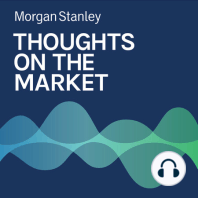3 min listen

Mike Wilson: Will 2022 be a 2013 ‘Taper Tantrum’ Redux?
Mike Wilson: Will 2022 be a 2013 ‘Taper Tantrum’ Redux?
ratings:
Length:
4 minutes
Released:
Jan 10, 2022
Format:
Podcast episode
Description
As the year gets underway, we are seeing an aggressive rotation from growth to value stocks, triggered by Fed tapering. Will 2022 follow the patterns of the ‘taper tantrum’ of 2013?----- Transcript -----Welcome to Thoughts on the Market. I'm Mike Wilson, Chief Investment Officer and Chief U.S. Equity Strategist for Morgan Stanley. Along with my colleagues bringing you a variety of perspectives, I'll be talking about the latest trends in the financial marketplace. It's Monday, January 10th at 11:30 a.m. in New York. So let's get after it. 2022 is off to a blazing start with one of the most aggressive rotations from growth to value stocks we've ever seen. However, much of this rotation in the equity markets began back in November, with the Fed's more aggressive pivot on monetary policy. More specifically, the most expensive stocks in the market were down almost 30% in the last two months of 2021. Year to date, this cohort is down another 10%, leaving 40% of the Nasdaq stocks down more than 50% from their highs. Is the correction over in these expensive stocks yet? What has changed since the turning of the calendar is that longer term interest rates have moved up significantly. In fact, the move in 10-year real rates is one of the sharpest on record and looks similar to the original taper tantrum in 2013. However, as already mentioned, equity markets have been discounting this inevitable move in rates for months. Perhaps the real question is, why is the rates market suddenly waking up to the reality of higher inflation and the Fed's response to it - something it has telegraphed for months? We think it has to do with several tactical supports that are now being lifted. First, the Fed itself likely increased its liquidity provisions at year-end to support the typical constraints in the banking system. Meanwhile, many macro speculators and trading desks likely shut down their books in December, despite their fundamental view to be short bonds. This combination is now reversed and simply added fuel to a fire that had been burning for months under the surface. Based on the move in 2013, it looks like real rates still have further to run, potentially much further. Our rates strategists believe real rates are headed back to negative 50 basis points, which is another 25 basis points higher. From our perspective, real rates are unreasonably negative given the very strong GDP growth. Therefore, the Fed is correct to be trying to get them higher. It's also why tapering may not be tightening for the economy, even though it's the epitome of tightening financial conditions for markets. We have discussed this comparison to 2013 in prior research and made the following observations as it relates to equity markets. First, the taper tantrum in 2013 was the first of its kind and something for which the markets had not been prepared. Therefore, the move in real rates was much more severe and swift than what we would expect this time around. Second, valuations were much more attractive in 2013 based on both price/earnings multiples and the equity risk premiums, which adjust for absolute levels of rates, which are much lower today. Listeners may find it surprising to learn that the price/earnings multiple for the S&P 500 is actually higher today than when the Fed first announced its plan to taper asset purchases back in September. In other words, valuations have actually increased as the tapering has begun, at least for the broader S&P 500 index. This is also similar to what happened in 2013 and makes sense. After all, Fed tightening is a good sign for growth and evidence that its policy has been successful. However, this time the starting point on valuations is much higher as already noted. More importantly, growth is decelerating, whereas in 2013 it was accelerating. This applies to both economic and earnings growth. In this kind of an environment, the most expensive parts of the market remain the most vulnerable. This argues for value to outperform
Released:
Jan 10, 2022
Format:
Podcast episode
Titles in the series (100)
Andrew Sheets: For Markets, Signs, Signs, Everywhere Signs by Thoughts on the Market